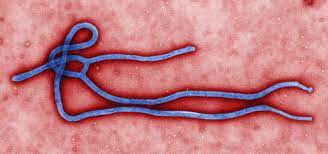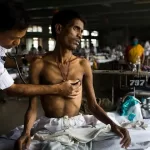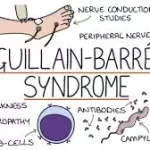On 11 January 2023, the Ministry of Health (MoH) of Uganda declared the end of the Ebola disease outbreak caused by the Sudan ebolavirus that affected nine districts. A total of 164 cases (142 confirmed, 22 probable) with 77 deaths (55 among confirmed cases and 22 among probable cases) were reported during the outbreak.
In accordance with WHO recommendations, the declaration was made 42 days (twice the maximum incubation period for Sudan ebolavirus infections) after the sample from the last admitted case that was collected on 29 November 2022 tested negative before discharge, and the last confirmed death was accorded a safe and dignified burial on 29 November 2022.
Although the outbreak has been declared over, health authorities are maintaining surveillance to rapidly identify and respond to any re-emergence. A follow-up programme has been put in place to support survivors. Neighbouring countries remain on alert and are encouraged to continue strengthening their capacities to detect and respond to infectious disease outbreaks.
Description of the situation
On 11 January 2023, the Ministry of Health (MoH) of Uganda declared the end of the Ebola disease outbreak caused by the Sudan ebolavirus (SUDV) that affected nine out of 146 districts: Bunyangabu, Jinja, Kagadi, Kampala, Kassanda, Kyegegwa, Masaka, Mubende, and Wakiso. This declaration follows a 42-day period after the last confirmed case tested negative on 29 November 2022 and was released from care on 30 November, and the last confirmed death was accorded a safe and dignified burial on 29 November 2022.
Uganda declared an outbreak of Ebola disease caused by Sudan ebolavirus on 20 September 2022, after a case at Mubende Regional Referral Hospital (MRRH) in Mubende district was confirmed by the Uganda Virus Research Institute (UVRI). In total,164 cases (142 confirmed, 22 probable) with 77 deaths (55 among confirmed cases and 22 among probable cases) and 87 recovered patients, were reported.
A higher proportion of cases occurred among males (59%), while the most affected age group was represented by those aged 20-29 years (31%), followed by those aged 30-39 years (30%). A quarter of cases were reported among children under 10 years old. Overall, 19 confirmed cases with seven deaths occurred among healthcare workers (HCWs).
Mubende was the epicentre of the outbreak, accounting for 45% of confirmed cases (64 confirmed and 19 probable), followed by Kassanda with 35% of confirmed cases (49 confirmed and 2 probable), Kampala with 13% of confirmed cases (17 confirmed and 1 probable), Wakiso with 3% of confirmed cases (4 confirmed cases), Kyegegwa with 2% of confirmed cases (3 confirmed cases), Jinja with 1% of confirmed cases (2 confirmed cases), and Bunyangabo, Kagadi and Masaka, which reported one confirmed case each (Table 1).
Table 1. Number of cases and deaths (confirmed and probable) of Ebola disease caused by SUDV, by district, as of 10 January 2023.
From 20 September to 10 January 2023, a total of 4793 contacts were listed and 11 025 alerts were reported, of which 8088 (73%) were investigated and 7382 (67%) were validated as suspected cases of Ebola disease caused by Sudan ebolavirus.
During this period, 1087 safe and dignified burials (SDB) were undertaken (all suspected deaths had to be tested and accorded a SDB), and 6681 samples were tested for Sudan ebolavirus.
A total of 314 603 travelers were screened at international points of entry and four suspected cases of SUDV were detected, who all tested negative.
Public health response
Coordination: Uganda MoH, together with WHO and other partners, initiated response measures to control the outbreak and prevent further spread. The MoH activated the national and district emergency management committees to coordinate the response.
Surveillance: WHO supported the MoH in the implementation of enhanced surveillance activities. Multidisciplinary teams were deployed to the field to actively search for cases, identify, list, and follow-up contacts for 21 days.
Partner support: Following a Global Outbreak Alert and Response Network (GOARN) Request for Assistance, a total of 69 offers of support were received from 23 partner institutions. Eleven experts were deployed to the field and three are still supporting the response in the functions of case management, infection prevention and control (IPC), and Go.Data implementation (Go.Data is the initiative of a group of public health partners and is managed by the GOARN with the aim to provide an outbreak investigation tool for field data collection during public health emergencies).
Over USD 27 million was mobilized from Development Partners in cash and in-kind contributions including from the United States Agency for International Development (USAID), UK Aid, Norwegian Government, Novo Nordisk Foundation, The Central Emergency Response Fund (CERF), Irish Aid, United Nations Development Programme (UNDP), The Directorate-General for European Civil Protection and Humanitarian Aid Operations (DG ECHO), Sweden, Luxemburg, the Republic of Korea and donors contributing to the WHO Contingency Emergency Funds (CFE).
Vaccination: WHO convened an expert meeting to prioritize candidate vaccines. In coordination with Ugandan researchers, health authorities, and regulators, a ring vaccination protocol was developed and locally approved. Three candidate vaccines were identified and over 5000 doses of these arrived in the country with the first batch on 8 December and the last two on 17 December.
Survivor Care Programme: Out of the 142 confirmed cases, 87 survivors were registered. An Ebola Survivors program (ESP) has been established following WHO guidance on clinical care for survivors of Ebola virus disease, with the goal to improve the wellbeing of survivors by integrating survivor health care into the National MoH System. WHO led the ESP planning, supported the needs assessments, and the establishment of three clinics, located in geographical areas where survivors are residing. Two of the three clinics are already operational. All survivors have had at least one clinical evaluation and have received at least one psychosocial support session with the clinic and community teams respectively.
Laboratory and clinical case management: WHO, GOARN, and partners supported the MoH in the establishment of screening, triage, isolation and care areas at designated reference hospitals in affected districts to identify suspected patients; and also supported the establishment of Ebola treatment centres in affected districts, and Ebola testing mobile laboratories. Treatment centres have been equipped with essential medicines and supplies to deliver safe, optimized supportive care, including personal protective equipment (PPE), monitoring devices, point-of-care laboratory testing, intravenous fluids, and supportive oxygen devices. WHO and GOARN deployed clinical experts and organized bio-secured, patient flow circuits that allowed close monitoring of cases. Over time, isolation areas and treatment centres were able to manage both suspected and confirmed patients according to WHO guidelines and standards. For confirmed patients, access to investigational products was provided within the locally approved expanded access protocols under the MEURI ethical framework while the Randomized Clinical Trial (RTC) protocol was under development.
Risk Communication and Community Engagement (RCCE) activities: WHO supported RCCE activities and awareness campaigns implemented by the MoH, as messages run by local radio stations, social media messages, door to door sensitisation of communities. A festive season RCCE plan was also developed to orient RCCE activities in Uganda and prevention in neighboring countries.
Preparedness in neighboring countries: Ministries of Health, WHO, in-country and international partners, supported Sudan Virus Disease (SVD) preparedness and operational readiness activities in neighboring countries that were identified as at-risk through risk assessments (Burundi, Central African Republic, the Democratic Republic of the Congo, Djibouti, Ethiopia, Kenya, Somalia, South Sudan, Sudan, Rwanda, and Tanzania).
Over 2000 health workers were trained during the outbreak on IPC, psychosocial support and care for both patients and affected families, and enhanced clinical care for SVD patients.
WHO risk assessment
The outbreak is declared over, with no new cases reported for 42 consecutive days.
This outbreak is not unexpected given that SVD is enzootic, present in animal reservoirs in the region. Uganda reported four SVD outbreaks in 2000, 2011, and two in 2012 prior to this last one in 2022, in addition to two Ebola outbreaks caused by the Zaire ebolavirus in 2007 and 2018. It is therefore likely that the filoviruses are present in the wild animal reservoir in the region. Thus, the risk of re-emergence of any filoviruses through exposure to an animal host or from a persistent virus cannot be excluded.
This outbreak showed that re-emergence of SVD is a major public health concern in Uganda. Strengthening of surveillance capacities can help to detect future outbreaks preventing further spread.
Ebola is a severe, often fatal illness affecting humans. While licensed therapeutics and vaccines are available, in limited numbers, to treat and prevent infections of Zaire ebolavirus, there are currently no licensed vaccines or therapeutics for SUDV.
WHO considers that ongoing challenges in terms of epidemiological surveillance, infection prevention and control programs and practices in health care settings, coupled with the impact of the COVID-19 pandemic, as well as ongoing outbreaks, such as Crimean-Congo haemorrhagic fever (CCHF), Rift Valley fever, yellow fever, cholera, and measles, might jeopardize the country’s ability to rapidly detect and respond to any re-emergence.
WHO advice
Successful SVD outbreak control relies on applying a package of interventions, including case management, early supportive care, risk communication and community engagement, surveillance and contact tracing, strengthening laboratory capacity, safe and dignified burials.
Although the outbreak has been declared over, WHO advises health authorities to maintain surveillance activities in place. Neighbouring countries are encouraged to remain on alert and continue strengthening their capacities to detect and respond to infectious disease outbreaks.
WHO advises the following risk reduction measures as an effective way to reduce SVD and other the transmission of other Ebolavirus diseases in humans:
- To reduce the risk of wildlife-to-human transmission from contact with wild animals such as infected fruit bats or non-human primates and the consumption of their raw meat, animals should be handled with gloves and other appropriate protective clothing. Meat should be thoroughly cooked before consumption.
- To reduce the risk of human-to-human transmission from direct or close contact with people with Ebola symptoms, particularly with their bodily fluids, people in affected communities should be encouraged to continue frequent hand hygiene including when entering or visiting health facilities and to remain alert for symptoms of Ebola.
- To reduce the risk of possible transmission from virus persistence in some body fluids, WHO recommends that recovered patients are provided with medical care, psychological support, and biological testing (until two consecutive negative tests) through an SVD survivors care programme. WHO does not recommend isolation of convalescent patients whose blood has tested negative for SVD.
- To prevent future amplification of transmission through health care, it’s recommended to strengthen IPC programmes within the health care system. Healthcare workers should always follow standard precautions when caring for patients, regardless of their presumed diagnosis. Implementation of IPC measures in health care (e.g. hand hygiene, training of health workers, adequate PPE supplies, waste management, environmental cleaning, and disinfection etc.) with ongoing monitoring and supervision is required.
- Provide training of the multi-disciplinary health workforce for early detection, isolation, and treatment of SVD cases as well as re-training on safe and dignified burials and the IPC ring approach.
- Ensuring the provision of safe and dignified burials, supporting IPC in community settings (including adequate water, sanitation and hygiene (WASH) facilities, hand hygiene capacity and safe waste management), implementing community engagement and social mobilization activities, are essential to prevent future transmission.
- Maintain capacities for logistic support in at-risk areas or countries, including supply chain (stockpiles) for essential medicines and supplies to deliver optimized supportive care for suspected and confirmed patients.
- Collect, analyse and report the clinical characterization of SVD patients in order to better understand the clinical phenotypes and presentation and care for patients in future outbreaks. Use of WHO Global clinical platform is recommended.
- Maintain capacities to surge SVD clinical care in case of future outbreaks; this includes screening protocols, referral pathways, SVD clinical guidelines, trained multidisciplinary staff for clinical surge, and designated infrastructure/health care sites that can provide patient-centered and community-acceptable SVD care that meets quality standards.
- Maintain capacities to surge and implement clinical trials on therapeutics using WHO RCT protocol in case of future outbreaks.
Based on the current risk assessment and prior evidence on Ebola outbreaks, WHO advises against any restriction of travel and trade to Uganda.
Further information
- WHO Africa. Uganda declares end of Ebola disease outbreak
- WHO Africa: Uganda declares Ebola Virus Disease outbreak
- WHO Africa. Ebola Virus Disease in Uganda SitReps
- WHO. Ebola, Uganda, 2022
- WHO Emergency Appeal: Ebola Disease Outbreak in Uganda
- Archive of Disease Outbreak News on Ebola disease caused by Sudan ebolavirus – Uganda
- Ministry of Health of the Republic of Uganda. Ebola Outbreak Statistics 2022
- WHO Africa. Bolstering Africa’s health emergency readiness and response
- WHO Africa. Rapid response teams bolster Uganda’s Ebola fight
- WHO Vaccine Prioritization Working Group. Summary of the evaluations and recommendations on the three Sudan ebolavirus vaccines that are candidates for inclusion in the planned ring vaccination trial in Uganda (Tokomeza Ebola)
- Solidarity Trials Core Protocol – Ring vaccination trial to evaluate the efficacy and safety of a Sudan ebolavirus vaccine in Uganda
- Sudan Ebolavirus – Experts deliberations. Candidate treatments prioritization and trial design discussions
- WHO steps up support to Uganda’s evolving Ebola outbreak as hope for vaccines increases
- Ebola virus disease fact sheet
- Optimized Supportive Care for Ebola Virus Disease. Clinical management standard operating procedures. WHO. 2019.
- Personal protective equipment for use in a filovirus disease outbreak: rapid advice guideline
- World Health Organization. (2021). Framework and toolkit for infection prevention and control in outbreak preparedness, readiness and response at the national level. World Health Organization. https://apps.who.int/iris/handle/10665/345251. License: CC BY-NC-SA 3.0 IGO
- Global health agencies outline plan to support Ugandan government-led response to outbreak of ebola virus disease
- ICD-11 2022 release
- Kuhn JH, Adachi T, Adhikari NKJ, et al. New filovirus disease classification and nomenclature. Nat Rev Microbiol. 2019;17(5):261-263. doi:10.1038/s41579-019-0187-4
- The WHO Global Clinical Platform for Ebola virus disease
- Global clinical data platform: Ebola virus disease case report form (CRF): module 1, 29 November 2022 (who.int)
- Global clinical data platform: Ebola virus disease case report form (CRF): module 2, 29 November 2022 (who.int)
- Global clinical data platform: Ebola virus disease case report form (CRF): module 3, 29 November 2022 (who.int)
Citable reference: World Health Organization (14 January 2023). Disease Outbreak News; Ebola disease caused by Sudan ebolavirus – Uganda. Available at: https://www.who.int/emergencies/disease-outbreak-news/item/2023-DON433











